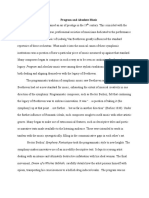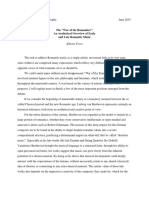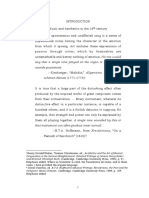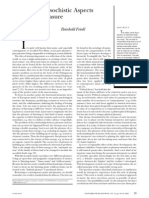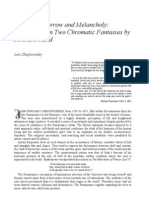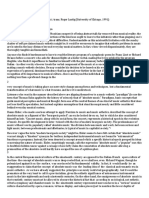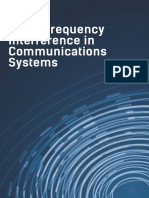Hoffmann Notes
Hoffmann Notes
Uploaded by
Shiloh JinCopyright:
Available Formats
Hoffmann Notes
Hoffmann Notes
Uploaded by
Shiloh JinOriginal Description:
Copyright
Available Formats
Share this document
Did you find this document useful?
Is this content inappropriate?
Copyright:
Available Formats
Hoffmann Notes
Hoffmann Notes
Uploaded by
Shiloh JinCopyright:
Available Formats
E.T.A.
HOFFMANN (1776 1822)
Born in Knigsberg, capital of East Prussia, home to Kant, Hamann, and
Herder. His father leaves the family when Ernst was only two years old. The
mother raises the family at her mothers home (grandmother and three
aunts). Ernst began piano lessons at home with his uncle, Otto Doerffer.
As a young man, he began composing music entirely inspired by Mozart
(whose Magic Flute would play a crucial role in Hoffmanns later story-telling:
mythic conflicts between Sarastro and the Queen of the Nightbody and
soul, male and female principles, etc.)
Age 16, he enters the University of Knigsberg to study law. Upon earning his
degree, he sets up a legal practice, first in Silesia and then in Berlin. He loses
his court position during Napoleons occupation (1806: Napoleons defeat of
the Prussian army in the Battle of Jena). Given his intense interest in music,
he decides to become a composer. He changes his middle name form
Wilhelm to Amadeus.
Within two years Hoffmann is appointed orchestra conductor in Bamberg, and
later in Dresden. Here, he begins to publish his first music reviews in the
prestigious journal, the Allgemeine Musikalische Zeitung, including his
seminal essay on Beethovens Fifth Symphony. He also begins to publish
short narrative pieces in the journal. His first story is Der Ritter Gluck, which
appears in 1809. He will later include this story as the leading piece in his
first collection of fiction, Die Fantasiestcke (1814).
BEETHOVEN S INSTRUMENTAL MUSIC
BEETHOVENS FIFTH SYMPHONY (1810)
REVIEW
OF
Most music historians identify Hoffmanns review of Beethovens Symphony
in C minor as the essay that instigated the discourse on absolute music,
which would dominate discussions of musical aesthetics throughout the 19 th
Century. Hoffmanns piece definitively sets the terms of the debate.
Although Hoffmann does not use the term absolute musicRichard Wagner
is accredited with later popularizing the ideahis approach to the musical
material fully belongs to this discourse.
Absolute music is music that has been emancipated or absolved from the
finite character of verbal language. It regards music as pure form, which
expresses infinite longing (a longing without decisive content). It is no longer
concerned with 18th-century restrictions, which deemed art valuable only if it
represented external reality (the natural and the social worlds) or depicted
individual sentiments. Absolute music represents or depicts nothing apart
from itself. The form is the content.
Hoffmann implies that absolute music is an expression of modernity. He
therefore engages in the major paradigm established by the Querelle des
Anciens et des Modernes of the late 17th Century.
Music history anticipates the Querelle, insofar as it labeled the antiqui as
musicians of the seconda prattica (monody, a rebirth of ancient Greek
practice, capable of depicting individual passions), as opposed to the
moderni who engaged in the prima prattica (polyphony, Church music,
intended to inspire devotion and the dissolution of the individual, who is now
perceived as a renegade).
The prima prattica of the moderni deals with infinite longing; the seconda
prattica of the antiqui deals with finite passions, with the determinate
feelings of the individual. In the 18th century this antithesis linked up with
debates on the origin of music: Rameau, who argued for the primacy of
harmony, took the side of the moderni; Rousseau, who lamented the loss of
the art of melody, was of the antiqui.
Absolute music is truly musical, as opposed to the representative style
(stilo representativo), which is more akin to sculpture. In his later essay on
Old and New Church Music (1814), Hoffmann writes: In the realm of art,
the two opposing poles of antiquity and modernity, or of heathendom and
Christianity, are sculpture and music. Christianity destroyed the one and
created the other.
True music is iconoclastic; it destroys sculptural determination. The ancient
gods, who were represented in statuary, have been replaced by the Christian
God, who is symbolized in a music that alone permits one to experience the
infinite. The beautiful has yielded to the sublime.
Instrumental music (harmony or polyphony) allows an intimation of the
supernatural, while vocal music (melody) is bound to nature.
Without any decoration or melodic verve, chords, mostly in root position and
consonant, follow one another, gripping the heart with their strength and
daring, and elevating it unto the highest. Love, the consonance of all that is
spiritual in nature, as it was endowed to the Christian, expresses itself in the
chord, which therefore first awakened to life in Christendom; and thus the
chord, harmony, becomes the image and expression of the communion of
souls, of union with the eternal, of the ideal that rules over us and yet
includes us (Old and New Church Music).
Yet, despite its capacity to dissolve the listener, the composer of sublime,
instrumental music mustlike Beethovenbe trained in musics science.
This science names a striving to know our heavenly home. Berglingers
anxiety regarding the grammar of art (how it leads to uninspired
productions) is now re-evaluated. Sublime music may not engage the
listeners cognitionit may overwhelm the listeners judgmental reflection
but the composer remains fully mindful of how he works through the musical
material.
Hoffmanns essay on Beethoven reveals these two aspects: on the one hand,
it shows how music can occasion an ecstatic (nearly mindless) experience;
while on the other hand, it shows how music can also be appreciated by the
mindnot necessarily reason, but a mindfulness that includes human
passion.
Hoffmanns term for this broader, more comprehensive mindfulness is
Besonnenheit, which connotes the collaboration of the mind and the senses
(Sinne). Besonnenheit implies a level-headedness in the midst of a powerful
experience: it names a sober intoxication (sobria ebrietas)a term
frequently used in the mystical tradition.
Beethoven himself was highly impressed by Hoffmanns review. Upon reading
it, the unsociable, unkind beast, actually wrote a rare letter of gratitude to
Hoffmann.
p. 59: Music:
an art of purity, radically independent of all other arts,
perfectly free,
perfectly autonomousanalogous to self-CS: unlimited,
indefinite, infinite.
Music is Orphic: insofar as it opens up an unknown realma nonexperiential sphere: our own origin and telos, both of which are
inaccessible by experience: we know we have a beginning and an end,
i.e., we know that there was and will be a time when we were not
conscious; and yet we cannot believe it, because we cannot experience
it (since experience is grounded in CS). Music permits us to experience
what cannot otherwise be experienced. Therefore:
Music is ascetic: insofar as it entails a turning away from the
experiential. Eine sehnsuchtstiftende Kraft
Composers who try to follow the standard of the plastic arts are
miserable, laughable, not memorable, for music is diametrically
opposed to the plastic: as time is opposed to space.
The misery of composers who try to make music mimetic, to make it
hold some truth content of reality, seems to lie in the ultimate failure
to convert space into time.
But is music purely temporal? Or is it not substituting one type of
space (real, three-dimensional space) for another (ideal, unreal,
otherworldly space). In the dream vision from Ritter Gluck, the
temporal cedes to the visible.
Music is pure form: and therefore has no content. But does the purity
of this art exclude nature altogether?
p. 60 Song: the admixture of music to poetry is somewhat successful, insofar
as it makes words (language) more palatablewith music one can
ingest or incorporate language, one can internalize to a certain extent
the external means of expression.
But the recent perfection of instrumental music, beginning with Mozart
and Haydn, culminates with Beethoven. This triumvirate of the new
musical empire, this trinity of the new musical religion, first perceived
musics true essence as something non-verbal, non-representational.
Haydn composed otherworldly realms: sylvan (getting lost), pastoral
(far from community), and prelapsarian (deathless): a paradise of no
suffering, no sorrow; only sweet melancholy.
Mozart leads us into the heart of the spirit realm and thereby
introduces an element of fear (fear of self-dissolution).
Beethoven: a full realization of the Sublime: his compositions are
monstrous and immeasurable and lead to the destruction of the
individual who is enraptured by the Spiritual (60-61).
Beethoven is the high priest of Romantic arta hierophant, a psychopomp:
leading the initiate further and further away from the vulgar crowd, the
profanum vulgus.
He is not manic: not daemonic: he is more like the god Hermes than like a
Pythia or a Sibyl. He enjoys full self-possession (Besonnenheit), an absolute
monarch over his art, a true genius (< gignomai: a genius that gives birth to
new worlds).
Unity in the symphonic works is only to be found by those initiated into the
high mysteries: it exists at a very deep level: in the intimate relationships
among the thematic material.
BEETHOVEN, SYMPHONY
IN C MINOR, OPUS 67
First performed: December 22, 1808, Vienna, Theater an der Wien, conducted
by the composer.
Beethoven spent four years composing this work, beginning in 1804, after
completing his famous Eroica Symphony Number 3. During this prolific
period, he also produced the first version of his Fidelio opera, the
Appassionata piano sonata, the three Razumovsky string quartets, his Violin
Concerto, and the Mass in C major.
The theme of the first movement is, of course, the most recognizable theme
in all of Western classical music: stunningly dramatic, forcefully simple, and
forever memorable. It is difficult today to measure the novelty and the power
of these opening bars for its first audiences.
Still, the symphonys reception was not particularly strongaudiences found
it difficult to comprehend its musical significance. They found the structure
confusing. Hoffmanns review, which appeared two years after the first
performance, played a substantial role in teaching audiences how to listen
and appreciate it.
As Hoffmann shows, there is a emphatic continuity that connects Beethovens
innovations with Haydn and Mozart.
The opening themethe three eighth notes dropping a thirdhas frequently
been described as fate knocking at the door, based on a remark that
Beethoven presumably made to his butler, Anton Schindler. Unfortunately,
Schindler is known to have fabricated many stories relating to his famous
employer.
Beethoven also reportedly explained to his famous student, Carl Czerny, that
the theme came to him from a yellow-hammer bird, singing in the Prater
park. Both sourcesthe sublime arrival of Fate and the pleasantly mundane
birdsonghowever different in ramifications, indicate that for Beethoven, the
basic musical material comes to him. It is a gift. Composition is therefore the
subsequent elaboration of this gift.
We are told that the symphony is in C minor, yet the entire opening theme
could just as well be in the relative major key of E-flat. Knowing that the key
is C minor causes the listener to hear the major key within a minor context,
which accounts for some of the musical tension. Beethoven is playing with a
certain kind of tonal ambiguity.
This tension is exacerbated by the rising note between the first and the
second figure: g-g-g eb / f-f-f d. We hear a general sense of falling, yet the
series of falls is based on a striving upward.
The tensional ambiguity eventually resolves with the proper beginning of the
movement at bar 6. The rhythmic drive alludes to working out the emotional
conflict set up by the brusque opening.
The gravitational pullthe continued fallingis counteracted by a lonely rise
upward, like the sustained g at bar 21 in fermataan individual tone held out
over an abyss that immediately overwhelms its cry.
The entire orchestra relentlessly imposes itself, until unison horns prepare the
ground for the second theme: a summoning of something less laden with
conflict, almost consoling. It rises to a nearly triumphal pitch.
Yet this calm, this triumph turns out to be momentary, the cellos and basses
slowly emerge to destroy any sense of complacency. And the first theme
returns to assert its gravitas. With the repeat of the Exposition, we now hear
the theme in C minor, no longer deluded into hearing E-flat major.
The subsequent Development builds momentum, pushing us ever forward,
without rest. Every ascent is countered by a powerful descent: eventually
landing in G minor (the fifth of C minor, not treated as a dominant, but as a
key in its own right). Here, the little motif leads to a formidable climax. With
great pathos, the oboe tries to disentangle itself from the heavy strings.
Block harmonies modulate rapidly before the Recapitulation enters: the
violins softly reiterate the theme, while the lower strings provide an ominous,
haunting undercurrent.
HOFFMANN, RAT KRESPEL (1817)
Hoffmann originally submitted the story for publication in Fouqus
Frauentaschenbuch. In the accompanying letter, Hoffmann at first excuses
his inability to supply a text.
Ive just been knocking on my forehead, like Rameaus splendid
[famoser] nephew, in sheer despair certainly, though pleading lightly
and asking very courteously: Isnt anyone, anyone at home?But no
answer!They have all gone out [ausgegangen], the masters and the
servants. Heaven knows if anyone will ever return or otherwise if at
least some good people will move in
Hoffmann often posits mental or spiritual evacuation as the ground of
possibility for inspiration. There must be space in order to receive the
transcendent transmission. Writing begins with dementia.
He knocks on his head, which thereby becomes a resonant body (cf. Herders
description of resonance). The knocking splits the subject into the one who
knocks and the one who is knocked upon. The integrity of the subject of
writing is fractured. It may also create a rhythmic pattern (an allusion to
Beethovens C minor symphony?) But is this rhythm enough to generate a
story?
Excuse me this time, most honorable Baron, and my own imbecility,
for which I blame only myself [deren ich mich selbst anklage]. . . .
Your most devoted servant, E. T. A. Hoffmann.
But then Hoffmann appends a postscript:
Postscriptum: Has it not, Baron, already happened quite often to you,
that out of the gray, gloomy, shadowy clouds that hung deep in your
life, there suddenly flashed out in colorful fire all sorts of friendly,
heavenly shapes [Himmelsgestalten]; and that after such illumination
only a blacker night enveloped you? But then in the far, far distance a
pale shimmer rose, and it spoke in your breast, ah, that is indeed the
beloved image, but only pain recognizes its magnificent, heavenly
traits. Now, as the shimmer began to take form [gestalten], with more
and more fiery beams, then you become aware that what appeared to
you as a shimmering, radiant image was but a reflex [Reflex] of the
heated, ineffable longing [unaussprechlichen Sehnsucht] that has
risen inside your very own self [die in Ihrem eigenen Innern
aufgegangen].
Hoffmann goes on to report how various shapes, terrible and inviting, began
to approach him. A devilish figure mocks his creative capacities, until at last,
from deep within [his] breast, a young woman appears. Immediately,
Hoffmann pronounces the name Antonie.
The name Antonia may be of Greek derivation, meaning priceless or
perhaps from anthos, flower. In German, the tone is particularly resonant.
For Hoffmann, it spells out a reflection or inverted Reflex of his own
monogram: AnToniE.
The devil departs and is replaced by an older, eccentric man: einer der
allerwunderlichsten Menschen, die mir jemals im Leben vorgekommenone
of the most astonishing people I have ever met in my life.
Thus the story of Rat Krespel proceeds, literally as a postscript. After writing
has failed, after the writers intention has been abandoned, the work takes
shape. (Cf. Benjamin: the Work is the death mask of intention) The story of
Rat Krespel comes after the end.
Fouqu publishes Rat Krespel together with the accompanying letter.
However, when Hoffmann later inserts the story in his Serapions-Brder
collection, the letter is removed.
Krespel is by no means a conventional artistin fact, it is difficult to call him
an artist in any determinate sense. By profession he is a member of the
towns judiciary body and works often as a diplomat. However, Krespel is
fundamentally creative, transforming his experience into an occasion for
artistic performance: building his home, making his own clothing, creating
childrens toys, making small boxes from rabbit bones.
The story centers on Antonie, a young woman with an unsurpassable voice.
The beauty of her tone, however, is due to a fatal defect in her chest. If she
continues to sing, she will certainly die young. Shaping her expression into
song would lead to the most horrible emptying out of all. Antonies potential
for song must resist formation. It must remain unrealized. For art to be
possible, art must be prohibited.
Antonies voice has become an object of rumor and myth: So it is that the
singing of Antonia on that single night has become among the people of the
town a fantasy and a legend of a glorious miracle, and even those who have
never heard her often say, []The only one who can sing is Antonia (166).
With Rat Krespel, Hoffmann posits an opposition between determinate
knowledge and open potential. At the beginning of the narrative, Krespel
builds a magnificent home without any blueprint or plan. The chief builder
complains: Ohne Fenster und Tren, ohne Quermauern? Wahnsinn
(31/160) Wahn (vanus = OHG, wan, ohne): Wahnsinn: ohne Sinn.
Krespels home is to be formed in the act, without a prior concept. Art as
something incalculable, contrary to determinate foreknowledge. Krespel
prefers to improvise. Only in this way will the house come out as it should.
Like Beethovens C minor symphony, the house, from the outside, has the
maddest appearance, until one penetrates its inner secrets of form (32f/161).
Whereas Hegel places symbolic architecture at the polar opposite of
romantic music, Hoffmann effortlessly combines the two arts.
The incongruity between mad exterior and pleasant
corresponds to Krespels eccentric nature (33f/162).
interior
The form of Rat Krespel itself reflects the bizarre, mad structure: early
commentators stressed the irregularities of the story, its disconnected,
anecdotal quality: the musical form disrupts the clear, linear unfolding of plot.
But perhaps this madness is only apparent from the outside.
As Dahlhaus suggests, the discourse of absolute music is instigated by a
desire to move beyond Kant, to demonstrate that there are areas of
knowledge that elude conceptual understanding. Absolute music is absolute
because it proceeds without concepts. In Hoffmanns letter to Fouqu, the
story of Rat Krespel only emerges after the author has renounced conceptual
planning.
In the story, however, due to his daughters predicament, Krespel arrives at a
concept: a way to prevent her from dying. The concept spells the end of art.
From that point on, instead of playing music, Krespel tears violins apart,
analyzing them, rendering them into mere pieces of wood. He is only eager to
discover some truth, but in doing so, he destroys music. Krespels scientificity
works at cross-purposes with his artistic temperament.
The concept maintains life, but a life without music. After Antonies death,
Krespel can return to his erratic, mad, musical life (42/173).
Antonie appears to represent the impossibility of artistic perfection. Here,
Hoffmann alludes to the Romantic notion that the perfect realization of the
Ideal must result in death. If the Ideal is infinite, it can only be achieved by
negating the finitude that defines human life. Every time Krespel hears
Antonie sing in her infinitely beautiful voice, he fears for her life.
Krespel experiences Antonies death in a grand Romantic vision, where love
and art transcend the limits of human finitude and approach eternity. When
Krespel sees her lying on the couch, he comments on her appearanceals
schliefe sie, und trume von Himmelswonne und Freudigkeit. A joy so
infinite that it requires the death of finite being.
HOFFMANN, THE FERMATA (1817)
p. 189:
Caricature, in the higher sense a critique of idealism, an
emphasis on the individual that breaks all form (totalitarian thinking,
cf. Benjamins correspondence to Adorno on Daumier).
The scene invites absorption. The picture brings its spectators onto the
threshold of art and life.
p. 190:
Like Berglinger, Theodore was faced with the predicament
between world and music.
p. 192:
In his first studies in Germany, he works on counterpoint,
following his masters scorn for monody.
p. 193:
The Italian feminine disrupts the fugue: the first in a series of
interruptions (either an Italian interruption of German art or a German
interruption of Italian art).
Lauretta and Teresina speak in a language that is explicitly nonGerman: the two parties fail to understand each other. The interruption
marks a crisis in language: a state of incommunicability.
p. 194:
The Italian singing brings Theodore beyond ideas: an awakening:
highly emotional
p. 195They now understand each otherthey have moved beyond language
difference. Theodore burns his counterpoint compositions.
You might also like
- The Inner Nature of Music and The Experience of Tone PDFDocument64 pagesThe Inner Nature of Music and The Experience of Tone PDFThiago Joseph100% (1)
- LovingSchumann BarthesDocument6 pagesLovingSchumann BarthesWaltVult100% (2)
- Creep Failure of HP Modified Reformer TubeDocument20 pagesCreep Failure of HP Modified Reformer Tubearaujo angel100% (1)
- Schopenhauer - Notes 1Document7 pagesSchopenhauer - Notes 1Çınar Esin AKILLINo ratings yet
- Program and Absolute MusicDocument5 pagesProgram and Absolute MusicAnonymous RrgVuPSeYENo ratings yet
- The War of The Romantics An AestheticalDocument5 pagesThe War of The Romantics An AestheticalPaulo Sequeira RebeloNo ratings yet
- Chapter 3: Absolute Music (Thomas Grey)Document46 pagesChapter 3: Absolute Music (Thomas Grey)MIGHEL SOLORZANO PEDROZANo ratings yet
- History of Western Philosophy of Music - Since 1800Document26 pagesHistory of Western Philosophy of Music - Since 1800IphiNo ratings yet
- Say That A Single Tone Played On The Organ or Harpsichord Sounds PassionateDocument9 pagesSay That A Single Tone Played On The Organ or Harpsichord Sounds PassionateVaizal AndriansNo ratings yet
- Some Sadomasochistic Aspects of Musical PleasureDocument3 pagesSome Sadomasochistic Aspects of Musical PleasureCarlos CuestasNo ratings yet
- Mazzini MusicDocument24 pagesMazzini MusicAxKleinNo ratings yet
- Mastery of Sorrow and Melancholy Lute News QDocument23 pagesMastery of Sorrow and Melancholy Lute News QLevi SheptovitskyNo ratings yet
- Hans Keller: HubermanDocument15 pagesHans Keller: HubermanAndrew WilderNo ratings yet
- Discursive Archetypes in The Music of Bedrich Smetana: Performing and Visual ArtDocument6 pagesDiscursive Archetypes in The Music of Bedrich Smetana: Performing and Visual ArtAlexandra BelibouNo ratings yet
- Spiritual Currents in Music (Joscelyn Godwin) PDFDocument12 pagesSpiritual Currents in Music (Joscelyn Godwin) PDFIsrael100% (3)
- Philosophy MusicDocument21 pagesPhilosophy MusicCamille Gabriel100% (1)
- Aristocratic Social Political Norms Age of EnlightenmentDocument4 pagesAristocratic Social Political Norms Age of EnlightenmentMohd Haffiszul Bin Mohd SaidNo ratings yet
- Lecture NotesDocument2 pagesLecture NotesClare CooneyNo ratings yet
- Rethinking Hanslick?Document9 pagesRethinking Hanslick?Arturo García GómezNo ratings yet
- Carl Dahlhaus The Idea of Absolute Music CH 1Document9 pagesCarl Dahlhaus The Idea of Absolute Music CH 1RadoslavNo ratings yet
- Wikipedia. Doctrine of Affections (Affektenlehre) Traducido Del AlemanDocument3 pagesWikipedia. Doctrine of Affections (Affektenlehre) Traducido Del Alemansercast99No ratings yet
- E. T. A. Hoffmann. Beethoven's Instrumental Music. 1813Document2 pagesE. T. A. Hoffmann. Beethoven's Instrumental Music. 1813MaríaPazTomasínNo ratings yet
- Outline 3Document24 pagesOutline 3Juan Oviedo-ReinaNo ratings yet
- Goethe Lyrics From A Schubertian Point of View AnaDocument16 pagesGoethe Lyrics From A Schubertian Point of View AnaJames MclaggenNo ratings yet
- The Largo Allegro From Beethovens Tempes PDFDocument13 pagesThe Largo Allegro From Beethovens Tempes PDFAnh Vu NgocNo ratings yet
- MUS ListenUnderstandMusic 2 Romanticism-Schoenberg - OCRDocument58 pagesMUS ListenUnderstandMusic 2 Romanticism-Schoenberg - OCRMCNo ratings yet
- Sorista EnglanniksiDocument4 pagesSorista EnglanniksiOtto VilleNo ratings yet
- Paper Research: THE SONG CYCLE by Laura TunbridgeDocument5 pagesPaper Research: THE SONG CYCLE by Laura TunbridgeBizzy ManessNo ratings yet
- What Is Speculative Music CompositionDocument19 pagesWhat Is Speculative Music CompositionManuel Brásio100% (1)
- Music LessonDocument7 pagesMusic LessonAlexNo ratings yet
- Colour and AffectDocument7 pagesColour and AffectSimone KotvaNo ratings yet
- Grove Philosophy of Music 2Document11 pagesGrove Philosophy of Music 2Orkun Zafer ÖzgelenNo ratings yet
- Overtones, a book of temperaments: Richard Strauss, Parsifal, Verdi, BalzacFrom EverandOvertones, a book of temperaments: Richard Strauss, Parsifal, Verdi, BalzacNo ratings yet
- Berio Un Re in Ascolto HeileDocument13 pagesBerio Un Re in Ascolto HeileMauricioNo ratings yet
- Aesthetics of MusicDocument7 pagesAesthetics of MusicErnodeHartNo ratings yet
- 04 Reading 9 - GaleDocument4 pages04 Reading 9 - GaleitsmecharliviiNo ratings yet
- Study For Baroque Exam 2 - Jake J.G-3Document2 pagesStudy For Baroque Exam 2 - Jake J.G-3curtis.colonestradaNo ratings yet
- Alexander Scriabin and Contemporaries From Central EuropeDocument19 pagesAlexander Scriabin and Contemporaries From Central EuropeTesis OsgNo ratings yet
- 1 Sinfonia EroicaDocument27 pages1 Sinfonia Eroicajorge santoroNo ratings yet
- Classical ComposersDocument13 pagesClassical ComposersYawen DengNo ratings yet
- Lira y PercusiónDocument12 pagesLira y PercusiónFuensanta Garrido DomenéNo ratings yet
- Handouts For Module 4 and 6 in MAPEHDocument6 pagesHandouts For Module 4 and 6 in MAPEHCharles Dominic BuñoNo ratings yet
- Revised EssayDocument11 pagesRevised EssaybronteldNo ratings yet
- The Beethoven Takeover: Joseph KermanDocument6 pagesThe Beethoven Takeover: Joseph KermanAugust Schorling HemmingsenNo ratings yet
- Heart in Hand: The Metaphysics of MusicDocument31 pagesHeart in Hand: The Metaphysics of MusicBradford OhblivNo ratings yet
- WK 4 BeethovenDocument9 pagesWK 4 BeethovenDylan YamadaNo ratings yet
- Joscelyn Godwin - Spiritual Currents in MusicDocument23 pagesJoscelyn Godwin - Spiritual Currents in MusicJay A. KlawierNo ratings yet
- Gesamtkunstwerk - Total Art Work Epic, Spectacle, Modeled On Greek Drama MusicDocument11 pagesGesamtkunstwerk - Total Art Work Epic, Spectacle, Modeled On Greek Drama MusicLin ShengboNo ratings yet
- Beethoven, a character study Together with Wagner's indebtedness to BeethovenFrom EverandBeethoven, a character study Together with Wagner's indebtedness to BeethovenNo ratings yet
- From The Writings of Schumann: Fifth Part: Dream of A Sabbath NightDocument7 pagesFrom The Writings of Schumann: Fifth Part: Dream of A Sabbath NightMichael WilhamNo ratings yet
- Styles of The Modern EraDocument4 pagesStyles of The Modern EraCarlos del Río SilvánNo ratings yet
- The Musicalization of The Visual Arts CoDocument28 pagesThe Musicalization of The Visual Arts CoolazzzzzNo ratings yet
- The Origins of String QuartetsDocument4 pagesThe Origins of String Quartetsmikecurtis1No ratings yet
- tmp6849 TMPDocument31 pagestmp6849 TMPFrontiersNo ratings yet
- Grove AbsoluteDocument4 pagesGrove AbsoluteSilvix 12No ratings yet
- Schopenhauer On The Power of Music - Brain PickingsDocument5 pagesSchopenhauer On The Power of Music - Brain PickingsMartyNo ratings yet
- Department of The Army Technical BulletinDocument44 pagesDepartment of The Army Technical BulletinglcainesNo ratings yet
- 1354 Athlete Cardiac Arrests, Serious Issues, 922 of Them Dead, Since COVID Injection - Real ScienceDocument205 pages1354 Athlete Cardiac Arrests, Serious Issues, 922 of Them Dead, Since COVID Injection - Real ScienceHansley Templeton CookNo ratings yet
- Permutation and Combination: Name - Tuhin Nayak Class - XI A' Roll No. - 29Document8 pagesPermutation and Combination: Name - Tuhin Nayak Class - XI A' Roll No. - 29Tuhin NayakNo ratings yet
- The 100 Most Cited Articles in Prosthodontic Journals: A Bibliometric Analysis of Articles Published Between 1951 and 2019Document7 pagesThe 100 Most Cited Articles in Prosthodontic Journals: A Bibliometric Analysis of Articles Published Between 1951 and 2019Najeeb UllahNo ratings yet
- Franck HertzDocument3 pagesFranck HertzHus-PhycsNo ratings yet
- Waves and em Spectrum Work SheetDocument2 pagesWaves and em Spectrum Work SheetSenpai ChibiNo ratings yet
- Phylord Dayag III Resume PHDocument3 pagesPhylord Dayag III Resume PHphdayag3No ratings yet
- 2020 01 14 Quantum EspressoDocument64 pages2020 01 14 Quantum EspressozhanzoNo ratings yet
- CPED NewDocument58 pagesCPED Newparatehardik448No ratings yet
- Assig 4Document22 pagesAssig 4api-335479337No ratings yet
- Sri LankDocument20 pagesSri LankVangeesa SumanasekaraNo ratings yet
- جزوه درس رادارDocument121 pagesجزوه درس رادارbahram bahramiNo ratings yet
- Competency Assessment Results Summary-FINALDocument1 pageCompetency Assessment Results Summary-FINALMark Aldwin LopezNo ratings yet
- Imam Ali - Tribute by Western IntellectualsDocument18 pagesImam Ali - Tribute by Western IntellectualsKaram Ali ShahNo ratings yet
- Stream CipherDocument16 pagesStream CipherSanjeev KumarNo ratings yet
- SolutionDocument7 pagesSolutionNishant kumarNo ratings yet
- Unit-Iii Sequence and Series: 2 Marks QuestionsDocument18 pagesUnit-Iii Sequence and Series: 2 Marks QuestionsAshish Sharma0% (1)
- CrystalDocument3 pagesCrystalNyx Bella DarkNo ratings yet
- EM g7 Maths 2021 WP 3rdDocument10 pagesEM g7 Maths 2021 WP 3rdNikila WeerasingheNo ratings yet
- National Rail Policy Green PaperDocument95 pagesNational Rail Policy Green PaperNicholas FeatherstonNo ratings yet
- F5 Solutions in The Public Cloud v3Document28 pagesF5 Solutions in The Public Cloud v3neoaltNo ratings yet
- Factors Influencing On Grade 12 Students Chosen Courses in Jagobiao National High School - Senior High School DepartmentDocument12 pagesFactors Influencing On Grade 12 Students Chosen Courses in Jagobiao National High School - Senior High School DepartmentBianca Marie Uypala ErquilangNo ratings yet
- My Love of Traveling by Sam HarrisDocument6 pagesMy Love of Traveling by Sam HarrisLeidy L. Machado Ferrer0% (1)
- Brgy Gulod Community Study (2008) (Binangonan, Rizal, Region 4A, Philippines)Document84 pagesBrgy Gulod Community Study (2008) (Binangonan, Rizal, Region 4A, Philippines)John Nicer AbletisNo ratings yet
- Imaginary and Complex NumbersDocument28 pagesImaginary and Complex NumbersZenonissya Galwan BataraNo ratings yet
- Radio Frequency Interference in Communication SystemsDocument229 pagesRadio Frequency Interference in Communication SystemsAika SumeragiNo ratings yet
- Aits 1718 CRT Iv Jeea Paper 1 Sol PDFDocument9 pagesAits 1718 CRT Iv Jeea Paper 1 Sol PDFsamarth goswamiNo ratings yet
- EAS Recommended Practices - Agile ContractingDocument79 pagesEAS Recommended Practices - Agile ContractingJustNo ratings yet
- ESP A.P English MTB Math Filipino MAPEH (Art) : GRADES 1 To 12 Daily Lesson LogDocument9 pagesESP A.P English MTB Math Filipino MAPEH (Art) : GRADES 1 To 12 Daily Lesson LogromelynNo ratings yet




